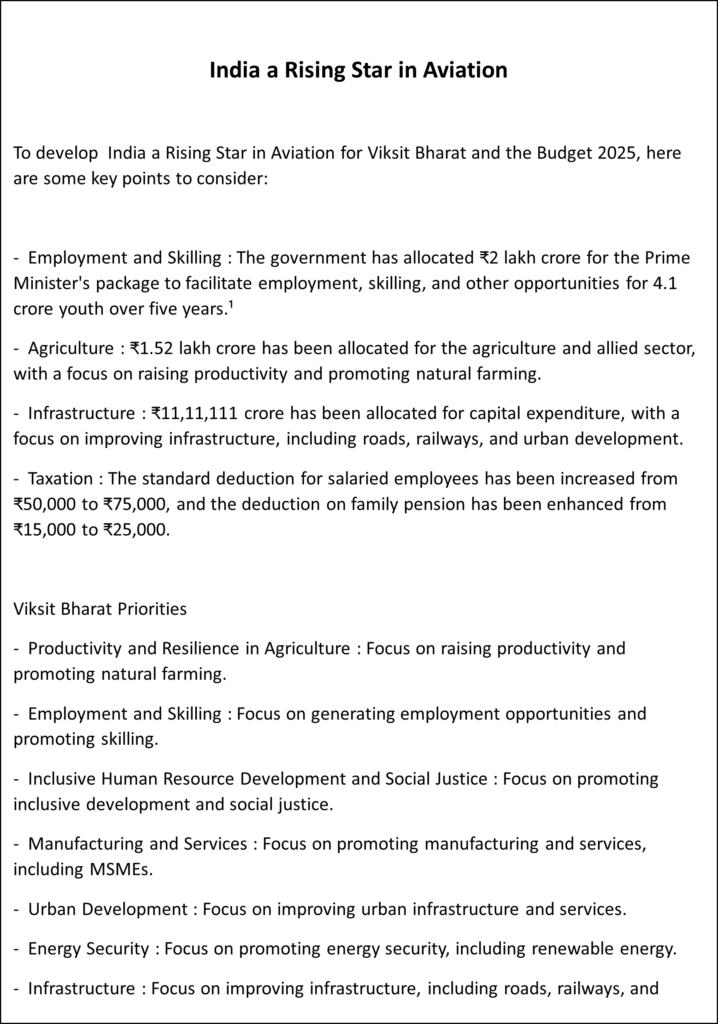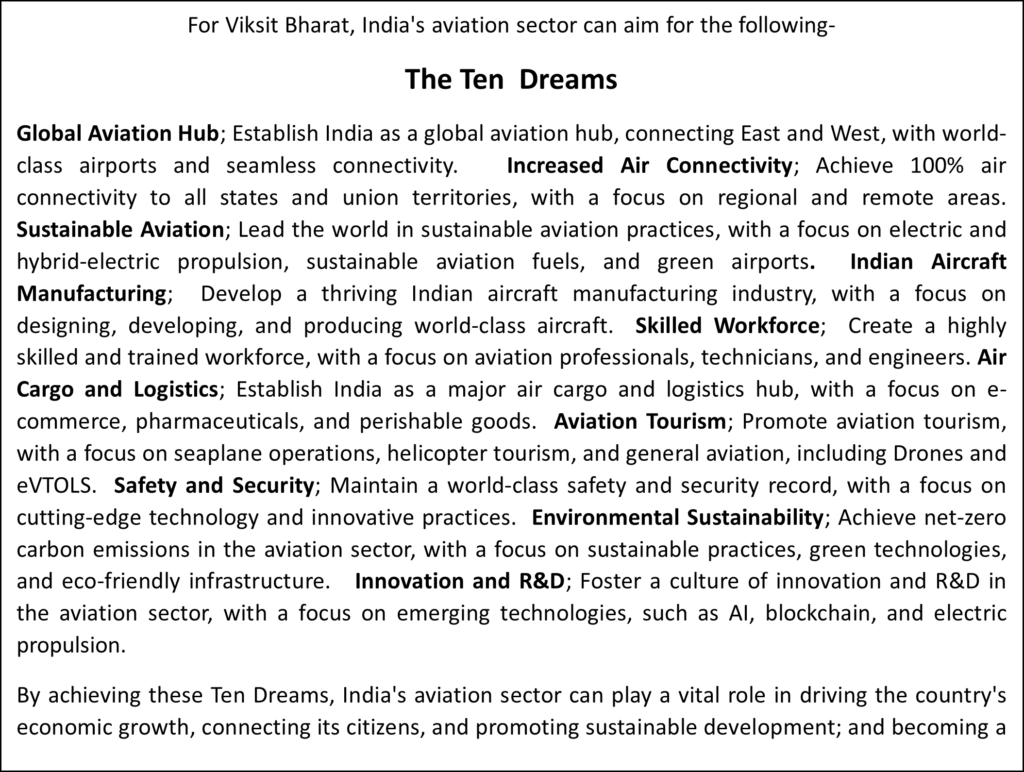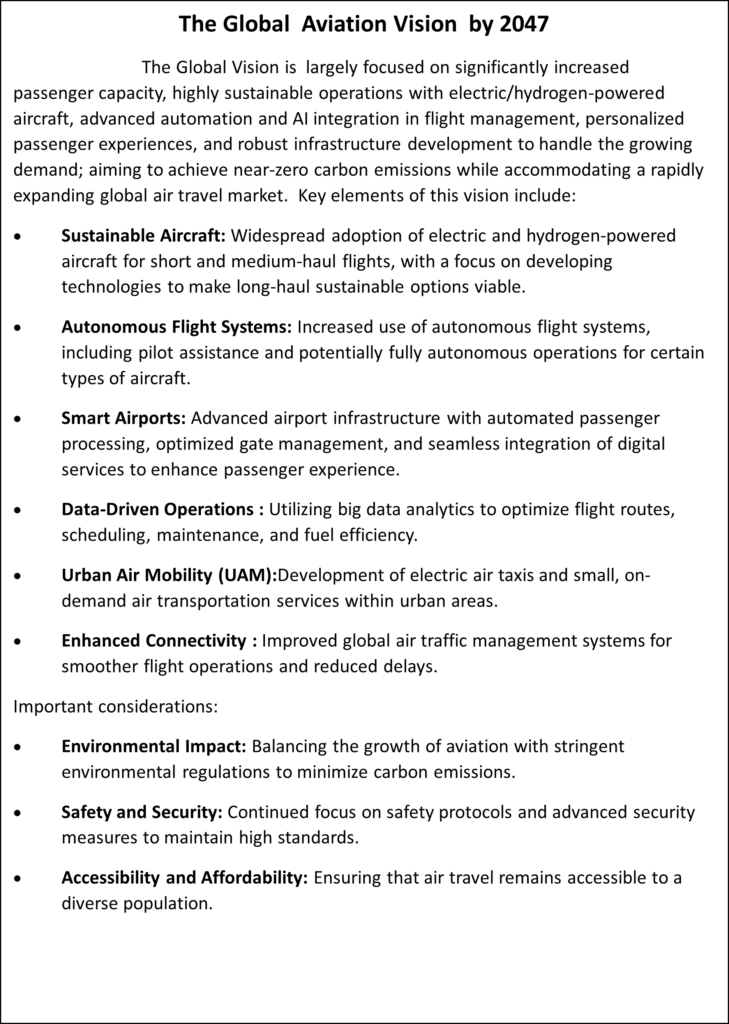By GS Bawa
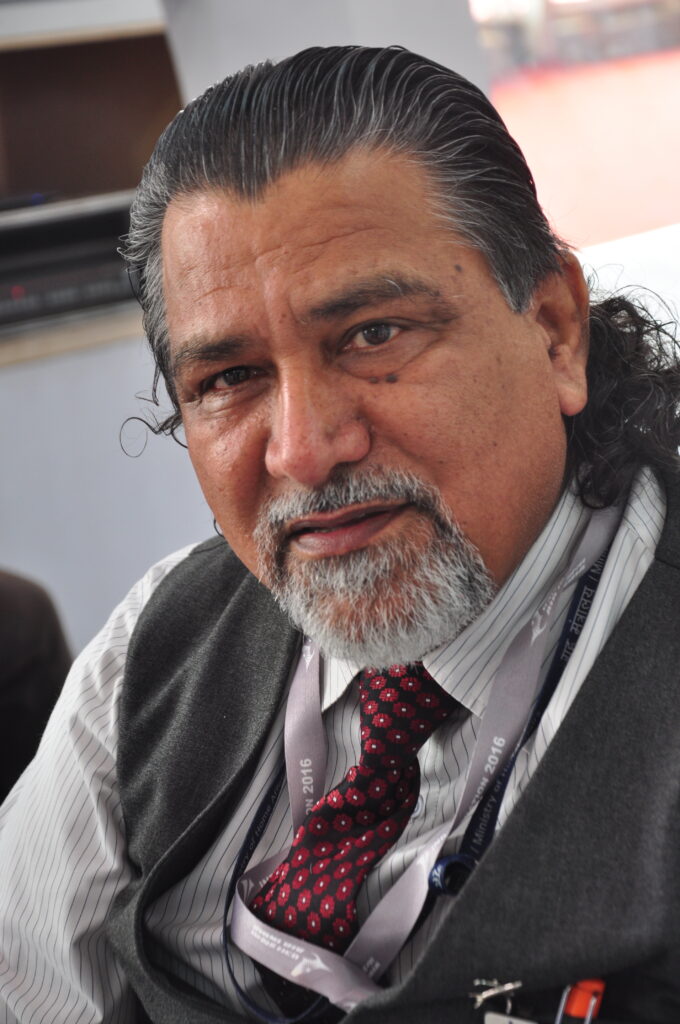
Today, India is the third-largest civil aviation market in the world. The country’s number of operational airports has more than doubled, increasing from 74 in 2014 to 157 today, bringing air travel closer to millions of Indians. Similarly, the aircraft inventory has doubled to more than 800, ensuring greater accessibility. From 2014 to 2024, domestic passenger traffic grew at a compound annual growth rate of 9.7%, while international passenger traffic grew at 4.5%.
The budget was out when I started writing on this concept note. Friends started saying that there is a budget cut here and there in the aviation sector and the future of aviation in the Viksit Bharat is bleak. I always have believed that Aviation should not be looked upon in isolation. I am a strong believer that Aviation in general and airports in particular are the Economic Magnets that build an ecosystem of its own; and if that is not disturbed, it follows a self-sustainable model. Air transport provides significant economic and social benefits. It facilitates tourism, trade, and connectivity, generates economic growth, provides jobs, improves living standards, alleviates poverty, provides a lifeline for remote communities, and enables a rapid response when disasters occur. We will dwell on this, further in the article; first, let’s take stock of the Breaking News of the Budget-2025, relating to Aviation & Tourism.
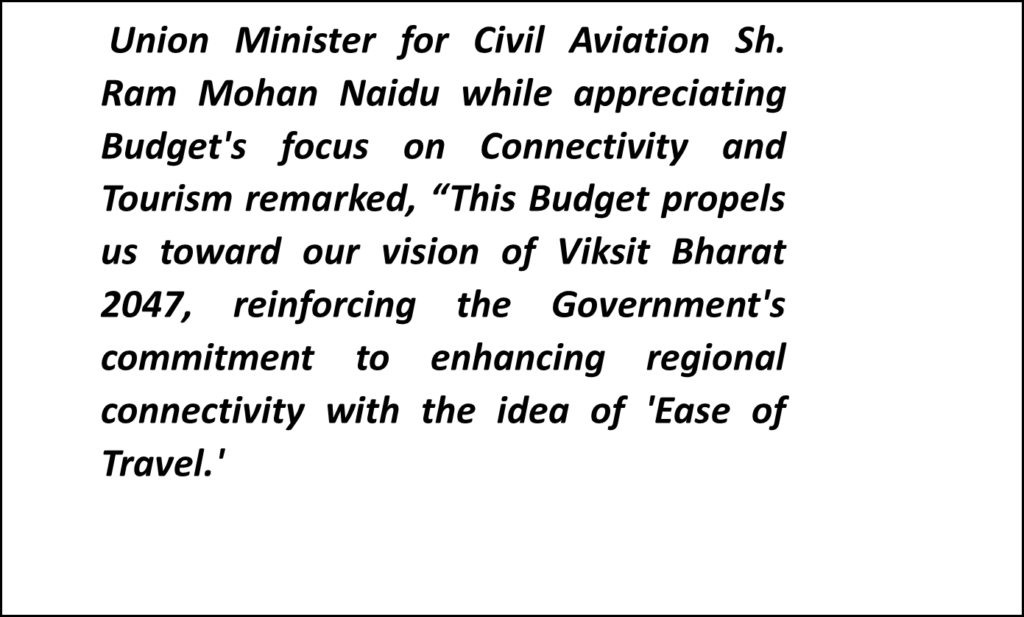
The Finance Minister has accepted that the UDAN scheme has been a success and a Modified – UDAN will be launched that shall connect 120 new destinations over the next decade. The reference to aviation in the budget, vide dedicated para-67 has been welcomed by, which reads as follows – “67. UDAN – Regional Connectivity Scheme: UDAN has enabled 1.5 crore middle-class people to meet their aspirations for speedier travel. The scheme has connected 88 airports and operationalized 619 routes. Inspired by that success, a modified UDAN scheme will be launched to enhance regional connectivity to 120 new destinations and carry 4 crore passengers in the next 10 years. The scheme will also support helipads and smaller airports in hilly, aspirational, and North-East region districts.”
The finance minister allocated 530 crores for UDAN in 2025-26, compared to the revised estimate of ₹800 crore in 2024-25. The scheme, launched by PM Narendra Modi in October 2016, aims to make air travel affordable by improving connectivity from unserved and underserved airports. The modified scheme will expand to include support for helipads and smaller airports in hilly, aspirational, and northeast-ern regional districts, she said. Further, according to the Economic Survey tabled in parliament, UDAN has already operationalized 619 routes connecting 88 airports, including two water aerodromes and 13 heliports. The survey also revealed that airport operators and developers, including the Airports Authority of India, have achieved 91% of their ₹91,000 crore capital expenditure plan for FY20-FY25 as of November 2024. I strongly believe that the UDAN scheme will further boost regional connectivity, fostering economic growth by enhancing trade, tourism, and investment opportunities across underserved and un-served areas.
Moving further towards Tourism, 50 new tourist spots are on the anvil to boost tourism and to boost jobs. The Budget Speech, para 75, titles its Tourism for employment-led growth; and reads as, Top 50 tourist destination sites in the country will be developed in partnership with states through a challenge mode. Land for building key infrastructure will have to be provided by states. In parallel, the Economic Survey 2024-25, released a day before the Budget, showed the tourism sector contributing 5% to GDP in FY23, matching pre-pandemic levels. The sector generated 76 million jobs, with international tourist arrivals returning to pre-pandemic levels. Yet, another significant announcement was the launch of the Gyan Bharatam Mission, which seeks to preserve and protect India’s manuscript heritage.
Before moving beyond aviation and tourism, and the symbiotic relationship that the two enjoy, I want to flag my concern about the arithmetic of several airports mentioned in two separate paragraphs of the Budget, 50 Destinations or say Tourist Spots and 120 Destinations envisaged to be connected under UDAN; are these separate making them 170 or 120 includes those 50? Synchronization of these airports and destinations is very important and there shall be a common nodal officer that shall ensure that these are not developed in isolation.
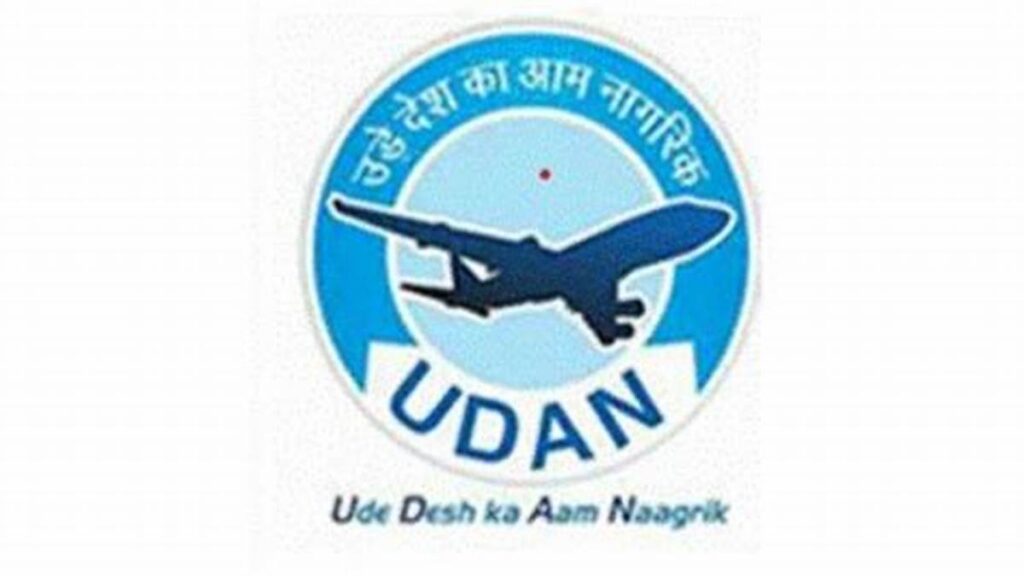
Now coming to India’s Self-reliance in Aerospace and its impact on the UDAN and the Regional Connectivity Scheme of the Government. India needs to manufacture a befitting aircraft that shall meet the challenges of the Regional Connectivity Scheme in terms of Economy, Efficiency and Reliability. This shall come from India’s aircraft manufacturing capability. For that, we need to cooperate with the needs of the Defence and Civil Aviation. While I was contemplating on this; the news item popped up – ‘Embraer has so far supplied eight jets to India for VVIP travel and use as airborne early warning and control aircraft. “#AeroIndia2025 will showcase the future of airpower with advanced technology, spectacular aerial displays and global aerospace innovations,” the defence minister’s office posted on X on Wednesday.” The US too looks forward to deepening the defence partnership and showcasing the best in aerospace innovation at Aero India, the US embassy in India posted on X on Wednesday.’
I was reminded of China, which has a system of Civil-Defence Fusion, also called Civil-Military Fusion. MCF may be there for a different purpose, but we shall learn from that to develop a Model that meets our (Indian) needs. Such a system shall be looked into, mainly, to pick up the finer points that shall make India a self-reliant nation to meet the needs of Aviation; be it Military or Civil. Such a system shall have positive Goals, e.g.:
- Shall support India in its transformation into a powerful nation in the field of Aviation.
- Shall help India at the national level to gain advantages in global technological and commercial competitions. India needs to close the gap in the development of disruptive technologies by advanced countries, including China.
- Overall, it shall provide opportunities for the improvement of India’s governance system in the field of Civil and Military needs. It will enable the creation of a governing system across sectors, government bodies and domains of other stakeholders.
- It shall support the creation of a world-class aviation system in the country. The strategy shall be to work with Stakeholders and other power centres to synergize the strategies in the manufacturing, MRO, cyberspace and the domains of airlines and airports.
The Vision for Viksit Bharat: India’s youth represent the country’s greatest strength, with a vibrant and dynamic generation driving the vision of making India a developed nation by 2047. However, the path to this ambitious goal is not without challenges. Aligned with the Prime Minister’s call for greater youth involvement in shaping the nation’s future. The initiative envisions India as a developed nation by the centenary of its independence in 2047. This transformative roadmap emphasizes inclusive development, sustainable progress, and effective governance. At its heart lies the active participation of India’s youth, which is regarded as the key driver of this change. The unique feature of the paradox is, that the Youth is both the agent of change and also the beneficiary of change.
The topic of the article, “Viksit Bharat’s Vision about Indian Civil Aviation”, sounds like a fascinating topic! The Viksit Bharat vision aims to transform India into a developed nation by 2047, and civil aviation plays a crucial role in this vision. The key points are the Civil Aviation Infrastructure, Youth and Innovation, and the Challenges ahead:
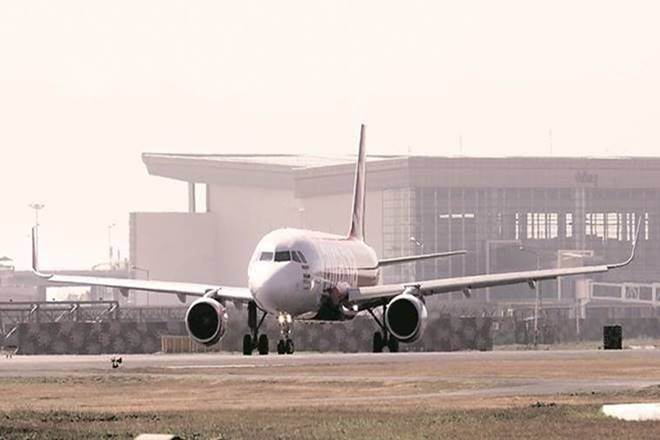
Civil Aviation Infrastructure:
- Increase in Airports: The government has plans to increase the number of airports from 157 to 350 by 2047. This will enhance domestic connectivity, especially to remote and unexplored locations.
- Increase in Routes: So far, the UDAN scheme has operationalized 619 routes and connected 88 airports across the country. Building on its success, a revamped UDAN initiative is proposed to be launched to further enhance regional connectivity, adding 120 new destinations.
- Increase in Traffic: The number of air passengers annually has surpassed 350 million, positioning India as the third-largest aviation market globally. Over the past ten years, domestic air passenger traffic has been growing at an annual rate of 10-12%, and the number of airports too have almost doubled, to 159 in number.
- Improved Infrastructure: Focus on upgrading existing airports and building new ones to handle increased air traffic.
- Enhanced Connectivity: Initiatives like the UDAAN scheme aim to connect previously unserved and underserved airports, making air travel more accessible.
- Seaplane and Helicopter Services: Expanding seaplane and helicopter services to improve access to remote areas.
- Tourism Boost: Airports are seen as gateways to the country, and improving facilities and hospitality at airports is expected to attract more foreign tourists.
- Economic Growth: A robust aviation sector is expected to contribute significantly to economic growth by boosting tourism, trade, and employment.
Youth and Innovation
- Youth Participation: The vision emphasizes the role of youth in driving progress. Encouraging young entrepreneurs and innovators in the aviation sector is seen as key to achieving the vision.
- Technological Advancements: Embracing new technologies and innovations in aviation to improve efficiency and safety. This shall include Drones and eVTOLs.
Challenges and Solutions
- Environmental Sustainability: Addressing environmental concerns related to aviation, such as reducing carbon emissions and promoting sustainable practices.
- Policy Reforms: Implementing policy reforms to create a conducive environment for growth in the aviation sector.
Viksit Bharat Vision and the SDGs: The Viksit Bharat vision aligns well with several Sustainable Development Goals (SDGs) set by the United Nations. Some connections, that I find relevant and specific alignment is needed for them; and are mentioned here. SDG 8, is essential for promoting sustained, inclusive, and sustainable economic growth through a robust aviation sector. SDG 9, needs to be aligned for Building resilient infrastructure and fostering innovation through enhanced connectivity and technological advancements. SDG 10, shall be aligned for reducing inequalities by providing equal access to air travel and economic opportunities. SDG 11, is important for promoting sustainable urbanization and inclusive communities by improving airport infrastructure. SDG 12, is Responsible for Consumption and Production balancing. SDG 13, shall be aligned for taking urgent action to combat climate change by addressing environmental concerns in aviation. The scope of these identified SDGs, for effective alignments are as follows-
- SDG 8: Decent Work and Economic Growth
- Economic Growth: A robust aviation sector boosts tourism, trade, and employment, contributing to sustained, inclusive, and sustainable economic growth.
- Youth Employment: Encouraging young entrepreneurs and innovators in the aviation sector aligns with promoting full and productive employment for all.
- SDG 9: Industry, Innovation, and Infrastructure
- Enhanced Connectivity: Expanding airports and improving infrastructure contribute to building resilient infrastructure and fostering innovation.
- Technological Advancements: Embracing new technologies in aviation aligns with promoting sustainable industrialization.
- SDG 10: Reduced Inequalities
- Equal Access: Expanding air travel to remote areas helps reduce inequalities by providing equal access to transportation and economic opportunities.
- SDG 11: Sustainable Cities and Communities
- Urban Development: Developing airports and improving connectivity can lead to more sustainable urbanization.
- Inclusive Communities: Ensuring that remote and underserved areas have access to air travel promotes inclusivity.
- SDG 12: Responsible Consumption and Production
- Sustainable Practices: Promoting sustainable practices in aviation, such as reducing waste and improving fuel efficiency, aligns with ensuring sustainable consumption and production patterns.
- SDG 13: Climate Action
- Environmental Sustainability: Addressing environmental concerns related to aviation, such as reducing carbon emissions, aligns with taking urgent action to combat climate change and its impacts.
Summing Up:
India’s Civil Aviation Ambitions by 2047: A Mixed Bag
As India sets its sights on becoming a global aviation hub by 2047, the latest budget allocation for the Ministry of Civil Aviation raises important questions. While the government’s emphasis on strategic investments and fiscal prudence is commendable, the decline in overall allocation is a cause for concern. Allocation Declines by 10%; the Ministry of Civil Aviation has seen a 10% decline in its budget allocation, from Rs 2,663.67 crore to Rs 2,400.31 crore. This decrease is puzzling, given the government’s stated ambitions for the sector.
Focus on Regional Connectivity and Innovation: However, within this reduced allocation, there are signs of strategic prioritization. The UDAN scheme, aimed at promoting regional connectivity, has received a modest 7.5% increase in funding to Rs 540 crore. This focus on ensuring the viability of regional airports and supporting air mobility solutions is crucial for India’s growth narrative.
Viability Gap Funding for Remote Regions: The government’s provision of Viability Gap Funding (VGF) for routes in the Northeast and other remote regions is a welcome move. This approach will help ensure that regional connectivity becomes financially sustainable in the long run.
Investing in Innovation: The increased allocation for production-linked incentives (PLI) for drones and drone components, from Rs 33 crore to Rs 57 crore, is a positive step. This emphasis on advanced technology and innovation aligns with India’s aspirations of becoming a global hub for modern aviation.
More Emphasis on Cargo Infrastructure for ‘ease of doing business’: Cargo is said to be a silent entity and does not cry; but shall not be ignored. Though the finance minister has addressed it in the budget speech, but still, needs to take it up as an independent item of growth. The finance minister in her address also underscored the government’s focus on upgrading air cargo infrastructure. India’s air cargo sector is growing at over 10% annually, with airport cargo handling capacity reaching 8.0 million MT in FY24. There is a special focus on air cargo warehousing, particularly for perishables, opening greater market opportunities for Indian producers and enhancing both exports and domestic trade efficiency. Streamlining cargo protocols will enhance efficiency and promote ease of doing business in the sector.
Conclusion: The government’s strategic focus on regional connectivity, innovation, and fiscal prudence is encouraging. As India strives to become a global aviation leader by 2047, it is essential to address the funding constraints and ensure that resources are directed where they will have maximum impact.

Recommendations: To achieve its ambitious goals, the government should consider the following:
1. Increase funding for the Ministry of Civil Aviation to support infrastructure development and regional connectivity.
2. Continue to prioritize strategic investments in innovation, such as drones, eVTOLs and advanced aviation technologies.
3. Ensure that the benefits of aviation growth are shared equitably among all regions and stakeholders.
By addressing these challenges and opportunities, India can unlock its full potential in civil aviation and emerge as a global leader by 2047. We are amidst a Revolution of Education through AI, and the world is looking upon India to lead. The Viksit Bhart with its ecosystem for aviation; success lies in the effective implementation of ‘India’s Own Aircraft & Own Market with Sustainability of Regional Connectivity’; It shall be another ‘DeepSeek of the Aviation World’. It is possible if we work in a symphony.
Jai Hind!
G.S. Bawa is a Senior Aviation Consultant & Advisor. A Former General Manager, Airports Authority of India, he is a highly accomplished aviation professional with decades of experience in airport management, economic planning, corporate planning, public relations, and general administration. Through his expertise in domains, such as Airport Planning & Development, Economic Planning, Statistical Analysis & Traffic Forecasting, Public Relations, International Cooperation, and Training & Development; as a seasoned aviation professional, G.S. Bawa offers strategic guidance and expertise to aviation organizations, leveraging his vast experience is his forte.
